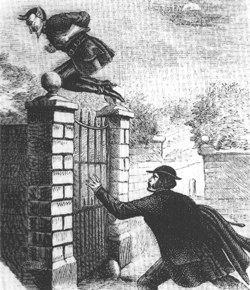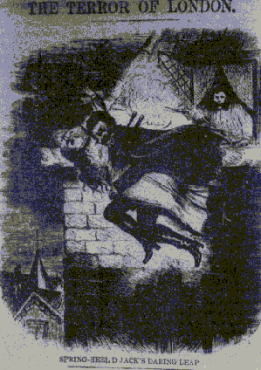Eighteen-year-old Jane Aslop did not want to go outside. It was dark, cold, and too late at night for any ordinary visitor, but the ring at the gate and her curious family compelled her to investigate. As she crossed the yard, she picked out a cloaked figure hunched just beyond the wall.
“Hello?” Jane asked. “Can I help you?”
“I am a policeman,” the figure snapped. “Quick, bring a light! We’ve caught Spring-heeled Jack!”
Jane knew that name, and trembled as she ran to fetch the officer a candle. He snatched it from her, pulling her arm. Then, instead of turning away, threw back his hood and held the light to his face.
Jane screamed. The man was not an officer, but a hideously ugly devil, with bulging eyes and a strange helmet. He grabbed her face and neck with metal talons, pulling her towards his chest, and then opened his mouth and vomited blue fire.
Jane screamed again, and, struggling, managed to break away and run back to the house. The thing caught her at the doorstep, pinning her down and scratching her, ripping out chunks of her hair. Her sisters, hearing her cries, came and managed with difficulty to pull her away. They stumbled back inside as a group, slamming the door her attacker’s face. The fiend did not stop, but pounded at the door.
Afraid for their lives, the family rushed upstairs and hung out the windows, screaming for the police. Only then did the devil laugh, turn, and vanish back into the dark. Jane collapsed against the door and sobbed with shock.
Spring-heeled Jack had come again.

Courtesy of Wikimedia Commons.
Though he might be familiar to British audiences (as well as fans of the show Luther, as I learned after writing this article), Spring-heeled Jack is, at least to me, new news. Most accounts put him in and around London from about 1837 through ‘67, though there have been sightings of him as late as the 1930’s. Miss Aslop’s was one of the first–and biggest–cases that brought real attention to his name. Jack was said to be a tall creature (with some reports putting him at ten feet), often dressed in a light-colored suit or oilskin and a dark cloak. He had talons in place of fingers, bulging eyes, and a strange lamp held to his chest. Most important of all, Spring-heeled Jack was said to be able to bound fifteen to twenty feet in the air, which he often did to attack his victim or escape the police. He was impervious to bullets. More than once he breathed fire.
Jack was fond of leaping through the night to terrorize people on the street–especially women walking alone–and, when that didn’t entertain him enough, attacked people at their own homes, playing games where he rang the bell and waited to reveal himself as a monster. He sexually assaulted, scratched, slapped, and beat people, tore chunks of hair from their head (as mentioned in the Aslop case), and caused carriages to crash by jumping suddenly into the middle of the road. People were driven into fits of fear at the sight of him, and did not recover for days. Many efforts were made to apprehend him, but none were successful–scapegoat after scapegoat passed before the local judges, but even when a few men were put away, the attacks continued.
As time passed, the monster morphed: a flame-spitting demon became a transparent ghost, a poltergeist, or just a good, old-fashioned assailant. Toward the end of his heyday, Jack took to torturing a group of sentries, sneaking up during the night watch to slip a cold, clammy hand over one of their faces, or slap them, hard, before laughing and bounding away again. Those in charge of the station issued threats, but to no avail–Jack continued to torture them, even giving one guard two black eyes. The attacks only stopped when the guards started to carry guns with live ammunition with them during their shifts at night.
And there was the curious thing–the thing that has led many to believe that Jack might not have so been supernatural after all. He seemed to respond to violent defense, even as people claimed he was impervious to their weapons. There were those that whispered, too, of a wager between a handful of young aristocrats to scare the public–a wager that got out of hand. Perhaps Jack was human, after all.
But if that were the case, not all of his appearances could have featured the same person. Fire breathing alone, for example, is a very particular skill. The money and time one would have to have to buy and craft so convincing a costume limits the candidates who might have pulled it off, as well–never mind the time it could take to do the pranks themselves, and in varying parts of the country. Even if the game was solely that of those aristocrats, and if two or three of them spread out to do it, they surely would have aged over the thirty years that Jack reined, which would make his exploits rather difficult at the end.
There remains also the issue of the jumping–even an Olympian champion might struggle to make the types of bounds ascribed to our bogeyman. Though we cannot underestimate the power of public imagination, the original claims must have come from somewhere. In his comprehensive and well-researched paper on Jack and his legacy, historian Mike Dash discusses the possibility of a special type of shoe that might assist such dramatic leaps, but ultimately dismisses it as an invention as likely to be dangerous to the wearer as to his victim, especially on as varied terrain as that of London and the English countryside. So if it wasn’t a shoe, and the accused aristocrats weren’t all better than Olympians, how do we have accounts of Jack bounding over carriages, or onto buildings?
Even if we ignore the issue of the jumping, and how particular a person would have to be to able to convincingly pull off Jack’s antics, the fact remains that, if we accept that he is human, more than one person must have done it. And that brings us to the true horror of the story. We know for certain that the original Sping-heeled Jack spawned dozens of copycat criminals who sought to hide their rape, burglary, and murders under his supernatural guise. Add the possibility of several people acting as the original Jack himself, and we have an enormous number of brutalities committed under his name.
Perhaps it does not matter so much whether or not Jack himself was real, if the horrors he inspired were.

Courtesy of Wikimedia Commons.
Have an excellent full moon my friends, and a better Thanksgiving.
If one can jump for joy, can they also jump for horror? Perhaps Jack was merely trying out a new aerobic routine? Share your thoughts in the comments below.
Featured image by Seb [ P34K ] Hamel.





0 Comments